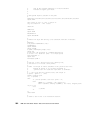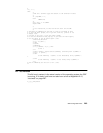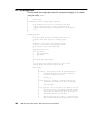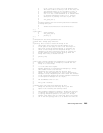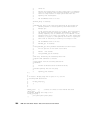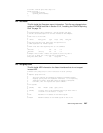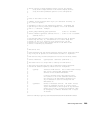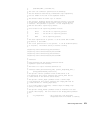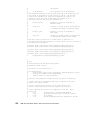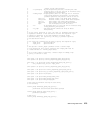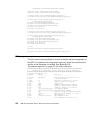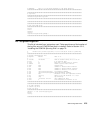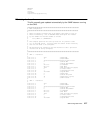270 IBM 9077 SP Switch Router: Get Connected to the SP Switch
#Service name=bc0 type=bcast addr=198.174.20.1 addr=198.174.22.1 \
# addr=198.174.21.1
#
# Traffic shaping parameters
#
# Lines beginning with the keyword "Traffic_Shape" define
# traffic shapes which may be used to configure the performance
# characteristics of ATM Virtual Circuits.
#
# The Traffic_Shape’s defined here are to be referenced by name when
# to assign traffic shapes to PVC’s or Interfaces later in this
# configuration file. (See Examples in the PVC or Interface section
# of this file for examples on how to reference traffic shapes defined here.)
#
# Each Traffic_Shape entry the ATM configuration file has the following format:
#
# Traffic_Shape name=value peak=bps [sustain=bps burst=cells] [qos=high|low]
#
# The "name" field is a unique name to identify this ATM service, so we
# can refer to the collection of peak, [sustain, burst], [qos] parameters
# as a group when configuring PVC’s or Interfaces later in this file.
#
# The ’peak’, ’sustain’, and ’burst’ fields specify, respectively,
# the peak cell rate, the sustained cell rate, and the burst rate.
# The values for ’peak’ and ’sustain’ are in kilobits per second (maximum
# of 155000), and the value for ’burst’ is in cells (maximum of 2048).
#
# The ’qos’ (Quality of Service) field specifies which rate queues
# to use. A value of ’high’ corresponds to high priority service
# which uses the high-priority rate queues, and a value of ’low’ corresponds
# to low priority service which uses the low-priority rate queues.
#
# The peak rate is the only parameter which is mandatory. If ommitted,
# the sustain and burst rates are set to match the peak rate. If qos
# is not specified, it defaults to "high".
#
#Traffic_Shape name=high_speed_high_quality \
# peak=155000 sustain=155000 burst=2048 qos=high
#Traffic_Shape name=medium_speed_low_quality \
# peak=75000 qos=low
#Traffic_Shape name=low_speed_high_quality \
# peak=15000 qos=high
#
# Signalling parameters
#
# Lines beginning with the keyword "Signalling" define
# the signalling protocol which will be used on a physical
# ATM interface to establish Switched Virtual Circuits for
# any logical interfaces on the named physical interface.
#
# Physical interfaces on GigaRouter ATM cards are identified by
# the slot number of the interface card in the GigaRouter chassis
# in hex notation (0-f) plus the location of the physical interface
# on the card (either the top connector, or the bottom connector on the card).
#
# Each Signalling entry the ATM configuration file has the following format:
#
# Signalling card=hex connector=top|bottom [protocol=UNI3.0|UNI3.1|NONE] \



